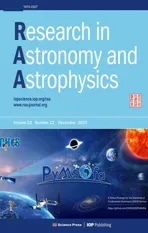The Study of the Physical Properties and Energy Sources of Five Luminous Type Ibc Supernovae
2024-01-16SongYaoBai白松瑶TaoWang王涛ShanQinWang王善钦WenPeiGan甘文沛LiuYiWang王浏毅andEnWeiLiang梁恩维
Song-Yao Bai (白松瑶), Tao Wang (王涛), Shan-Qin Wang (王善钦), Wen-Pei Gan (甘文沛), Liu-Yi Wang (王浏毅), and En-Wei Liang (梁恩维)
1 Guangxi Key Laboratory for Relativistic Astrophysics, School of Physical Science and Technology, Guangxi University, Nanning 530004, China shanqinwang@gxu.edu.cn 2 Nanjing Institute of Astronomical Optics & Technology, Nanjing 210042, China Received 2023 June 12; revised 2023 August 7; accepted 2023 August 30; published 2023 October 25
Abstract In this paper, we study five luminous supernovae (LSNe) Ibc (SN 2009ca, ASASSN-15mj, SN 2019omd,SN 2002ued, and SN 2021bmf) whose peak absolute magnitudes Mpeak are ≈−19.5 to −21 mag by fitting their multi-band light curves(LCs)with different energy source models.We find that SN 2009ca might be powered by the 56Ni model since the required 56Ni mass (0.56 M⊙)is comparable to those of energetic SNe Ic,while the rest four SNe cannot be accounted for the 56Ni model since their derived 56Ni masses are ≿1 M⊙or the ratios of the 56Ni mass to the ejecta mass are larger than 0.2.This indicates that some LSNe might be powered by 56Ni decay,while most of them need additional energy sources.We then use the magnetar plus 56Ni model and the fallback plus 56Ni model to fit the LCs of the four LSNe that cannot be explained by the 56Ni model, finding that the two models can account for the four SNe, and the derived parameters are comparable to those of LSNe or superluminous SNe in the literature,if they were(mainly)powered by magnetars or fallback.We suggest that the magnetar plus 56Ni model is more reasonable than the fallback plus 56Ni model, since the validity of the fallback plus 56Ni model depends on the value of accretion efficiency(η)and favors a large η value,and the magnetar plus 56Ni model yields smaller χ2/dof values.It should be pointed out that, however, the fallback plus 56Ni model is still a promising model that can account for the four SNe in our sample as well as other LSNe.
Key words: Stars – (stars:) supernovae: general – stars: magnetars
1.Introduction
Core-collapse supernovae (CCSNe) result from the explosions of massive stars with zero-age main-sequence mass(MZAMS≿8.0 M⊙) (Woosley et al.2002; Janka et al.2007).It is believed that the progenitors losing most or all hydrogen envelopes can produce stripped-envelope SNe (SESNe) which can be divided into type IIb SNe,type Ib SNe,and type Ic SNe(see Filippenko 1997; Gal-Yam 2017 for reviews), for which the progenitors lost most hydrogen envelopes, all hydrogen envelopes, and most helium envelopes, respectively.
Most types Ib and Ic(type Ibc)SNe are dimmer than type Ia SNe whose peak absolute magnitudes Mpeakare ∼−19.5 mag.Over the past two decades, however, a few hundred superluminous type Ibc SNe (SLSNe Ibc) with Mpeak≾−21 mag were confirmed and comprehensively studied (see Gal-Yam 2012 and Gal-Yam 2019 for reviews).Additionally, a few dozen luminous type Ibc SNe (LSNe Ibc) whose Mpeakare between ∼−19.5 and ∼−21 mag are also been studied.3
Unlike normal type Ibc which is believed to be (mainly)powered by the cascade decay of56Ni synthesized by the explosions (Colgate & McKee 1969; Colgate et al.1980;Arnett 1982), the energy sources of LSNe Ibc and SLSNe Ibc are still elusive.
Previous studies for SLSNe Ibc indicate that almost all SLSNe cannot be explained by the56Ni model (including the pair-instability SNe model which need a few M⊙of56Ni).To account for the light curves (LCs) of SLSNe which cannot be explained by the56Ni model, three models which are the magnetar model (Maeda et al.2007; Kasen & Bildsten 2010;Woosley 2010;Inserra et al.2013;Wang et al.2015a),the SN ejecta-circumstellar medium (CSM) interaction (CSI) model(Chevalier 1982; Chevalier & Fransson 1994; Chatzopoulos et al.2012, 2013), and the fallback accretion model (hereafter the fallback model;Dexter&Kasen 2013;Moriya et al.2018a,2018b; Anderson et al.2018; Li et al.2020) have been proposed.
The case for LSNe Ibc is more complicated.Wang et al.(2015b) suggest that the magnetar plus56Ni model is a promising model to account for LSNe Ic since the56Ni masses needed by the56Ni model are larger than the reasonable values,while the contribution of a moderate amount of56Ni cannot be neglected.Wang et al.(2015b) use the magnetar plus56Ni model to fit the bolometric LCs of three LSNe Ic-BL(SN 2010ay, SN 2006nx, and SN 14475), and find that the model can explain their LCs and the derived parameters for magnetar were P0∼7–15 ms and B ∼(4–7)×1014G.Gomez et al.(2021) investigated SN 2019stc and found that the first and second peaks in this SN could be powered by the magnetar plus56Ni decay and the ejecta-CSM interaction, respectively.Gomez et al.(2022) used the magnetar plus56Ni model to fit the multi-band LCs of 40 LSNe with r band Mpeakbetween−19mag and −20 mag, finding that the parameters of magnetars were P0∼1–23 ms and B ∼(0.1–13)×1014G.
In this paper,we collect the multi-band data of five LSNe Ibc with Mpeak≈−19.5 to −21mag, and constrain their physical properties by using the56Ni model, the magnetar plus56Ni model,as well as the fallback plus56Ni model to fit their multiband LCs.In Section 2, we model the multi-band LCs of the five LSNe using these three models.In Section 3, we discuss our results and draw some conclusions in Section 4.Throughout the paper, we assume Ωm=0.315, ΩΛ=0.685,and H0=67.3 km s−1Mpc−1(Planck Collaboration et al.2014).The values of the Milky Way reddening (EB−V) of all events are from Schlafly & Finkbeiner (2011).
2.Modeling the Multi-band Light Curves of Five LSNe
We collect about 50 LSNe Ibc with Mpeak≈−19.5 to−21mag from the Open Supernova Catalog (Guillochon et al.2017)4https://sne.spaceand the public catalog of transients from the Zwicky Transient Facility(ZTF)Bright Transient Survey(BTS)(Perley et al.2020).5https://sites.astro.caltech.edu/ztf/bts/bts.phpWe then exclude the LSNe which had been fitted by the literature (e.g., Wang et al.2015b; Gomez et al.2021,2022), and obtain the rest five LSNe, which are SN 2009ca,ASASSN-15mj, SN 2019omd, SN 2021bmf, and SN 2022ued.Among the five LSNe, ASASSN-15mj, SN 2019omd, and SN 2022ued are SNe Ib,while SN 2009ca and SN 2021bmf are broad-lined SNe Ic (SNe Ic-BL).The information of the five LSNe is listed in Table 1.
2.1.Modeling the Multi-band LCs of Five LSNe Using the 56Ni Model
We first use the56Ni model to fit the multi-band light curves(LCs) of the five SNe in our sample.The details of the56Ni model can be found in Wang et al.(2023) and references therein.Throughout this paper, κ is set to be 0.07 cm2g−1.Definitions,units,and prior ranges of the free parameters of the56Ni model are listed in Table 2.We use the Markov Chain Monte Carlo (MCMC) method to derive the medians and 1σ confidence regions of the parameters through the emcee Python package (Foreman-Mackey et al.2013).
The fits for the five SNe using the56Ni model are shown in Figure 1.The parameters and the corresponding corner plots are presented in Table 3 and Figures A1–A5.

The derived values of Mej, MNi, vph, and EKare ∼(0.7–8.0) M⊙, ∼(0.7–5.0) M⊙, ∼(1.0–2.5)×109cm s−1, and∼(1.0–25.0)×1051erg,respectively; the mean values of these parameters are ∼5.45 M⊙, ∼2.79 M⊙, ∼1.73×109cm s−1,and ∼10.0×1051erg, respectively.The ratios of MNito Mej(f) of the five SNe are ∼0.22–0.99.
By comparing our derived parameters to those in the literature, we find that the values of derived MNiand f of the56Ni model are consistent with those derived from other LSNe using the56Ni model,which are ∼(1.0–2.0)M⊙and 0.31–0.62(Wang et al.2015b) or ≈3.2 M⊙and ∼0.31 (Gomez et al.2021).
As pointed out by Khatami & Kasen (2019) and Arnett(1982), Afsariardchi et al.(2021)ʼs model might overestimate the56Ni masses of SNe.More reasonable56Ni masses can be derived by using the equation (Khatami & Kasen 2019)
the mean values of β for Type Ib and Type Ic-BL SNe are 0.66 and 0.56,respectively(Afsariardchi et al.2021);the rise time tpand the peak luminosity Lpare given by the bolometric LC reproduced by the best-fitting parameters of multi-band LCs fits.Using the equation, the56Ni masses of the five SNe are 0.56 M⊙, 0.44 M⊙, 0.99 M⊙, 2.26 M⊙, and 2.28 M⊙,respectively.The values of f are ∼0.10 (SN 2009ca), ∼0.56(ASASSN-15mj),∼0.12(SN 2019omd),∼0.36(SN 2021bmf),and ∼0.36 (SN 2022ued), respectively.

Table 2Definitions, Units, and Prior Ranges of the Parameters of the 56Ni modela

Table 3Medians, 1σ Bounds, and Best-fitting Values (in Parentheses) of the Parameters of the 56Ni Model

Figure 1.The best fits(the solid curves)of the multi-band LCs of SN 2009ca(the top-left panel),ASASSN-15mj(the top-right panel),SN 2019omd(the middle-left panel), SN 2021bmf (the middle-right panel), and SN 2022ued (the bottom panel) using the 56Ni model.The shaded regions indicate 1σ bounds of the parameters.Circles represent observed data, triangles represent upper limits.

Table 4Definitions, Units, and Prior Ranges of the Parameters of the Magnetar Plus 56Ni, and the Fallback Plus 56Ni Modelsa
Umeda&Nomoto(2008)suggest that the upper limit of the value of f of CCSNe is 0.2.Therefore, ASASSN-15mj,SN 2021bmf, and SN 2022ued cannot be explained by the56Ni model.Although f of SN 2009ca and SN 2019omd is smaller than 0.2, the derived56Ni mass of SN 2019omd is 0.99 M⊙, which is about twice those of some very energetic SNe Ic(e.g.,SN 1998bw,SN 2003dh).Hence,we suggest that the56Ni mass of SN 2019omd is also unreasonable.Finally,the possibility that SN 2009ca was powered by56Ni decay cannot be excluded, since its56Ni mass derived (0.56 M⊙) is comparable to those of SN 1998bw, SN 2003dh, and other energetic SNe Ic.
2.2.Modeling theMulti-bandLCsofFourLSNe Using t he MagnetarPlus56Ni ModelandtheFallbackPlus 56Ni Model
Here,we use the magnetar plus56Ni model and the fallback plus56Ni model to fit the multi-band LCs of ASASSN-15mj,SN 2019omd,SN 2021bmf,and SN 2022ued.The details of the two models can be found in Wang & Gan (2022) and Wang et al.(2023)and references therein;definitions,units,and prior ranges of the free parameters of the two models are listed in Table 4.
The fits of the two models for the four SNe are shown in Figure 2.The parameters and the corresponding corner plots are presented in Table 5 and Figures A6–A13.We find that the LCs of four SNe can be well fitted by the two models.The χ2/dof values of the best fits of ASASSN-15mj, SN 2019omd,SN 2021bmf, and SN 2022ued using the magnetar plus56Ni model (the fallback plus56Ni model) are respectively 0.82(1.10),0.55(0.58),0.93(1.00),and 1.90(2.01),indicating that the magnetar plus56Ni model is better than the fallback plus56Ni model for the four LSNe.

Figure 2.The best fits(the solid curves)of the multi-band LCs of ASASSN-15mj,SN 2019omd,SN 2021bmf,and SN 2022ued using the magnetar plus 56Ni model(the left panels)and the fallback plus56Ni model(the right panels).The dotted lines are the LCs powered by the56Ni,and the dashed lines are the LCs powered by the magnetar(the left panels)or the fallback(the right panels),respectively.The shaded regions indicate 1σ bounds of the parameters.Circles represent observed data,triangles represent upper limits.
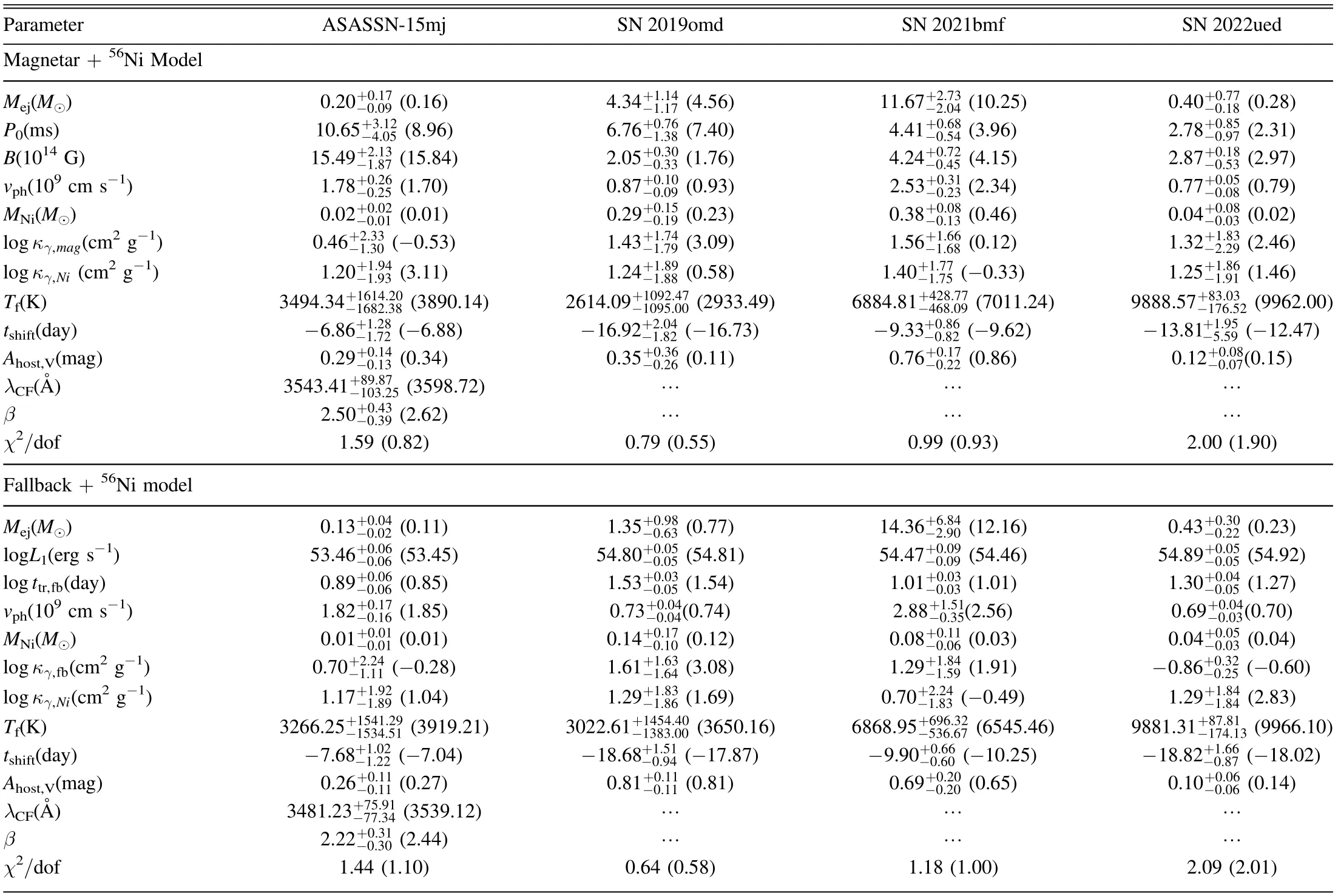
Table 5Medians, 1σ Bounds, and Best-fitting Values (in Parentheses) of the Parameters of the Magnetar Plus 56Ni Model and the Fallback Plus 56Ni Model
Based on the derived Mejand vph,we can calculate the values of EKof the SNe.For the magnetar plus56Ni model (the fallback plus56Ni model),EKof ASASSN-15mj,SN 2019omd,SN 2021bmf, and SN 2022ued are 2.84×1050erg (2.25×1050erg), 2.38×1051erg (2.53×1050erg), 3.35×1052erg(4.76×1052erg), and 1.07×1050erg (6.78×1049erg),respectively.Using Equation (1), the56Ni masses of ASASSN-15mj, SN 2019omd, SN 2021bmf, and SN 2022ued derived by the magnetar plus56Ni model(the fallback plus56Ni model) are 0.01 M⊙(0.01 M⊙), 0.11 M⊙(0.07 M⊙), 0.21 M⊙(0.01 M⊙), and 0.02 M⊙(0.03 M⊙), respectively.
For the magnetar plus56Ni model,the derived values of Mej,MNi, P0, B, vph, and EKare ∼(0.1–10) M⊙, ∼(0.01–0.5) M⊙,∼(2–9) ms, ∼(1–15)×1014G, ∼(0.7–2.4)×109cm s−1, and∼(0.10–35.0)×1051erg, respectively; the mean values of these parameters are ∼3.81 M⊙, ∼0.18 M⊙, ∼5.66 ms,∼6.18×1014G, ∼1.44×109cm s−1, and 9.07×1051erg,respectively.
For the fallback plus56Ni model, the derived values of Mej,MNi,L1,ttr,fb,vph,and EKare ∼(0.1–12)M⊙,∼(0.01–0.1)M⊙,∼(0.2–8)×1054erg s−1, ∼(7–35) days, ∼(0.7–2.6)×109cm s−1, and ∼(0.10–48.0)×1051erg, respectively; the mean values of these parameters are ∼3.32 M⊙, ∼0.05 M⊙,∼4.49×1054erg s−1, ∼17.65 days, ∼1.46×109cm s−1,and ∼1.20×1052erg, respectively.
The derived MNiof the magnetar plus56Ni model and the fallback plus56Ni model are respectively ∼0.01–0.21 M⊙and∼0.01–0.07 M⊙, which are consistent with those of normal SNe Ic.Moreover,other parameters of the two models are also in reasonable ranges and comparable to those derived in the literature (e.g., Wang et al.2015b; Gomez et al.2022).Therefore, we suggest both the magnetar plus56Ni model and the fallback plus56Ni model are reasonable.
3.Discussion
3.1.The Masses of the Ejecta of ASASSN-15mj and SN 2022ued
The ejecta masses for ASASSN-15mj and SN 2022ued are 0.16 M⊙and 0.28 M⊙(the magnetar plus56Ni model), and 0.11 M⊙and 0.23 M⊙(the fallback plus56Ni model),respectively.These values are significantly lower than the range of ejecta masses of SLSNe and normal Ib/c SNe in the literature which are 1–40 M⊙(Blanchard et al.2020) and 1–10 M⊙(Prentice et al.2019), respectively.
The small derived ejecta masses of the two SNe might be due to the absence of pre-peak data which results in poor constraints for the rise time and therefore the ejecta masses.Otherwise,the two SNe are ultra-stripped LSN like iPTF16asu(Whitesides et al.2017; Wang & Gan 2022).
3.2.Comparison with Previous Studies
Assuming that ASASSN-15mj, SN 2019omd, SN 2021bmf,and SN 2022ued are powered mainly by magnetars,we plot the distribution of P0and B(see Table 5)of the magnetars assumed to power the LCs of the four LSNe that we study and those of the magnetars associated with the LSNe studied by Gomez et al.(2022) and the SLSNe studied by Nicholl et al.(2017),see Figure 3.It can be found that the parameter space of the putative magnetars powering the LCs of the four SNe that we study overlaps both that of the LSNe studied by Gomez et al.(2022) and the SLSNe studied by Nicholl et al.(2017).Moreover, the derived upper limit of P0(∼11 ms) of our sample is smaller than that (∼23 ms) of Gomez et al.(2022),while the derived lower limit of P0(∼3 ms) of our sample is larger than that (∼1 ms) of Nicholl et al.(2017).This is because the peak absolute magnitudes of our sample are in−19.5 to −20.5 mag, while the peak absolute magnitudes of Gomez et al.(2022) and Nicholl et al.(2017) extend to −19 and <−21 mag, respectively.
Assuming that ASASSN-15mj, SN 2019omd, SN 2021bmf,and SN 2022ued are powered mainly by fallback, we plot the distribution of L1andttr(see Table 5) of the four LSNe and those of SLSNe studied by Moriya et al.(2018a),see Figure 4.It can be found that the parameters of the four SNe we study are located in the lower right of the parameter space (largerttrand lower L1) while the parameters of SLSNe studied by Moriya et al.(2018a) are located mainly in the upper left of the parameter space (smallerttrand higher L1).It should be noted that,however,there is a small overlap between our sample and the sample of Moriya et al.(2018a).
3.3.The Accretion Masses and the Validity of the Fallback Plus 56Ni Model
For the fallback plus56Ni model, the accretion mass Macccan be written as (Moriya et al.2018a)
here,η is the efficiency of converting accretion to input energy which can be from ∼0.001 (Dexter & Kasen 2013) to ∼0.1(e.g., McKinney 2005; Kumar et al.2008; Gilkis et al.2016).Using the equation, the accretion masses of the four LSNe are 0.0005–0.0547 M⊙, 0.0043–0.4345 M⊙, 0.0043–0.4378 M⊙,0.0084–0.8472 M⊙, respectively.The accretion masses are significantly smaller than the derived56Ni masses if η is set to be the upper limit (0.1).In contrast, the accretion masses are larger than the derived56Ni masses if η is set to be the lower limit (0.001).Therefore, the validity of the fallback plus56Ni model depends on the value of η and favors a large η value.
4.Conclusions
In this paper, we study five LSNe with Mpeak≈−19.5 to−21mag by fitting their multi-band LCs with different energy source models.We find that the56Ni model cannot account for the LCs of four SNe (ASASSN-15mj, SN 2019omd,SN 2002ued, and SN 2021bmf) in our sample, since f of the three SNe(ASASSN-15mj,SN 2002ued,and SN 2021bmf)are larger than the upper limit(0.2)of f value of CCSNe,while the derived56Ni mass of SN 2019omd is 0.99 M⊙, which is about twice those of some very energetic SNe Ic.For comparison,the derived56Ni mass (0.56 M⊙) of SN 2009ca is comparable to those of energetic SNe Ic, indicating that it might be powered by the56Ni cascade decay.This indicates that some LSNe might be powered by56Ni cascade decay,though most of them need additional energy sources.
We use the magnetar plus56Ni model and the fallback plus56Ni model to fit the LCs of the four LSNe that cannot be explained by the56Ni model, finding that the two models can account for the four SNe.The χ2/dof values of the best fits of the two models suggest that the magnetar plus56Ni model is better than the fallback plus56Ni model for the four LSNe.
For the magnetar plus56Ni model, Mej, MNi, P0, B, vph, and EKare ∼(0.2–10)M⊙,<0.3 M⊙,∼(2–9)ms,∼(1–15)×1014G,∼(0.7–2.4)×109cm s−1, and ∼(0.10–35.0)×1051erg, respectively.These values are comparable to the typical values of the magnetars supposed to power the LCs of LSNe(see,e.g.,Wang et al.2015b; Gomez et al.2022) and some SLSNe (see, e.g.,Nicholl et al.2017).For the fallback plus56Ni model,Mej,MNi,L1,ttr,fb, vph, and EKare ∼(0.1–12) M⊙, ∼(0.01–0.1) M⊙,∼(0.2–8)×1054erg s−1, ∼(7–35) day, ∼(0.7–2.6)×109cm s−1, and ∼(0.10–48.0)×1051erg, respectively.
It should be noted that, however, the derived Mejof ASASSN-15mj and SN 2022ued are respectively 0.16 M⊙(0.11 M⊙) and 0.28 M⊙(0.23 M⊙) for the magnetar plus56Ni model(the fallback plus56Ni model),which are comparable to those of ultra-stripped SNe.This might be due to the absence of pre-peak data which prevents us from better constraining the rise time and therefore the ejecta masses; or the two SNe are ultra-stripped LSN like iPTF16asu.
Finally, we find that the distribution of P0and B of the putative magnetars powering the LCs of the four SNe overlaps those of the magnetars of LSNe and SLSNe in the literature, if they are (mainly) powered by magnetars.Similarly, the distribution of L1andttrof the fallback powering the LCs of the four SNe overlaps those of the fallback of SLSNe in the literature, if they are (mainly) powered by fallback.
We suggest that the magnetar plus56Ni model is more reasonable than the fallback plus56Ni model,since the validity of the fallback plus56Ni model depends on the value of η and favors a large η value,and the magnetar plus56Ni model yields smaller χ2/dof values.It should be pointed out that, however,the fallback plus56Ni model is still a promising model that can account for the four SNe in our sample as well as other LSNe.
Acknowledgments
We thank the anonymous referee for the helpful comments and suggestions that have allowed us to improve this manuscript.Song-Yao Bai thanks Deng-Wang Shi (石登旺),and Qiu-Ping Huang(黄秋萍)for their helpful discussion.This work is supported by the National Natural Science Foundation of China (grant Nos.11963001, 12133003, 11833003,11973020 (C0035736), and U1938201).
Appendix
Figures A1–A5 are the corner plots of the56Ni model of SN 2009ca, ASASSN-15mj, SN 2019omd, SN 2021bmf, and SN 2022ued, respectively.Figures A6–A9 are the corner plots of the magnetar plus56Ni model of ASASSN-15mj,SN 2019omd, SN 2021bmf, and SN 2022ued, respectively.Figures A10–A13 are the corner plots of the fallback plus56Ni model of ASASSN-15mj,SN 2019omd,SN 2021bmf,and SN 2022ued, respectively.
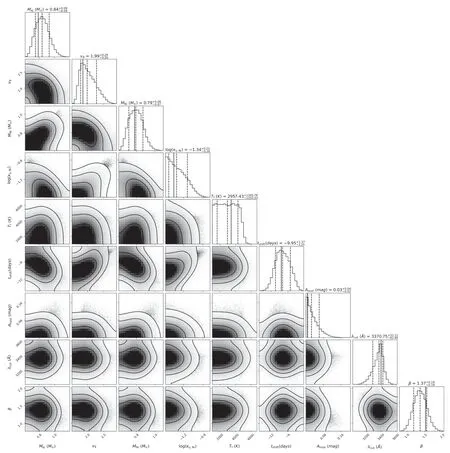
Figure A2.The corner plot of the 56Ni model for the multi-band LCs of ASASSN-15mj.The solid vertical lines represent the best-fitting parameters,while the dashed vertical lines represent the medians and the 1σ bounds of the parameters.

Figure A6.The corner plot of the magnetar plus 56Ni model for the multi-band LCs of ASASSN-15mj.The solid vertical lines represent the best-fitting parameters,while the dashed vertical lines represent the medians and the 1σ bounds of the parameters.

Figure A8.The corner plot of the magnetar plus 56Ni model for the multi-band LCs of SN 2021bmf.The solid vertical lines represent the best-fitting parameters,while the dashed vertical lines represent the medians and the 1σ bounds of the parameters.

Figure A9.The corner plot of the magnetar plus 56Ni model for the multi-band LCs of SN 2022ued.The solid vertical lines represent the best-fitting parameters,while the dashed vertical lines represent the medians and the 1σ bounds of the parameters.

Figure A10.The corner plot of the fallback plus 56Ni model for the multi-band LCs of ASASSN-15mj.The solid vertical lines represent the best-fitting parameters,while the dashed vertical lines represent the medians and the 1σ bounds of the parameters.
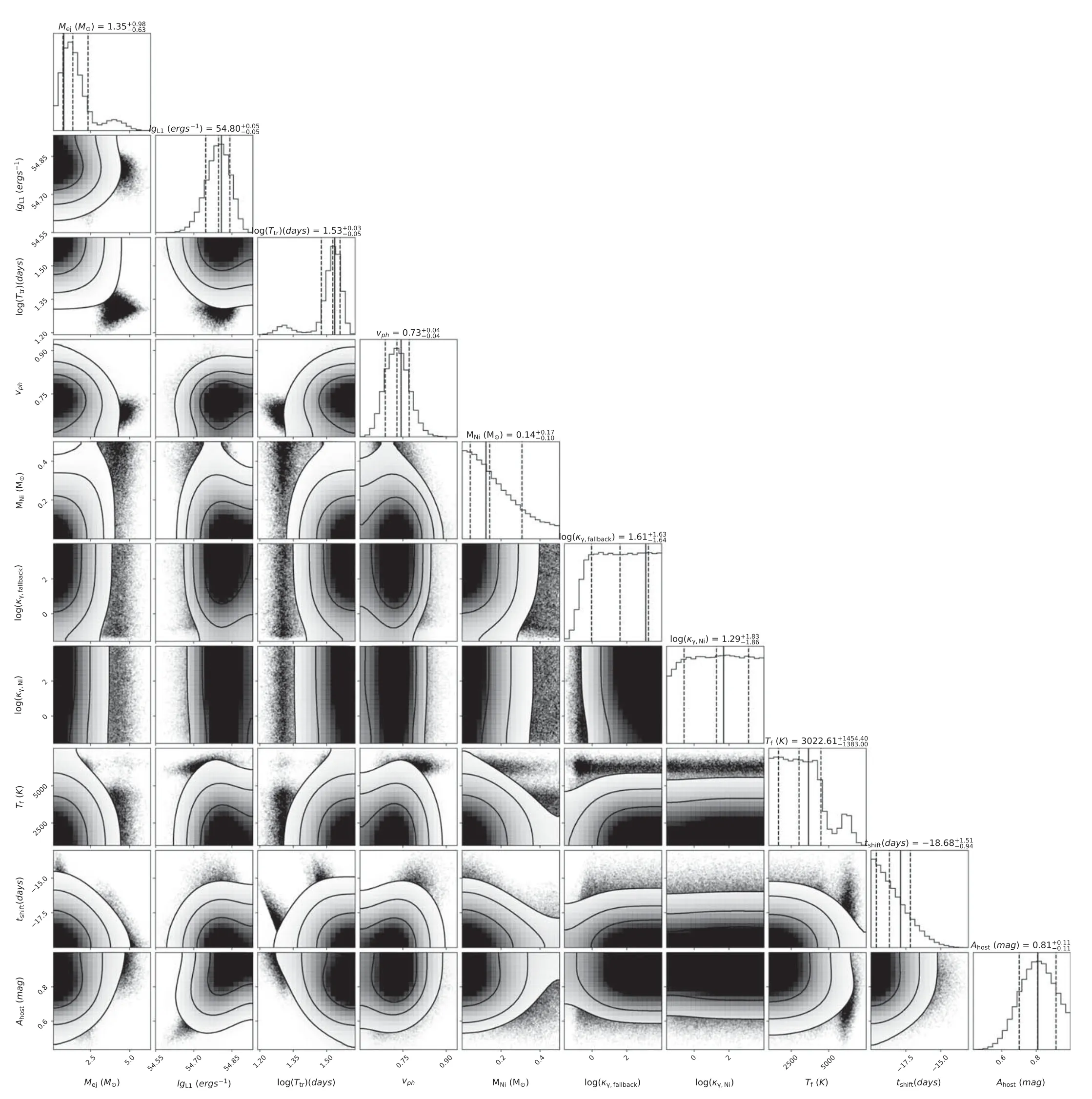
Figure A11.The corner plot of the fallback plus 56Ni model for the multi-band LCs of SN 2019omd.The solid vertical lines represent the best-fitting parameters,while the dashed vertical lines represent the medians and the 1σ bounds of the parameters.
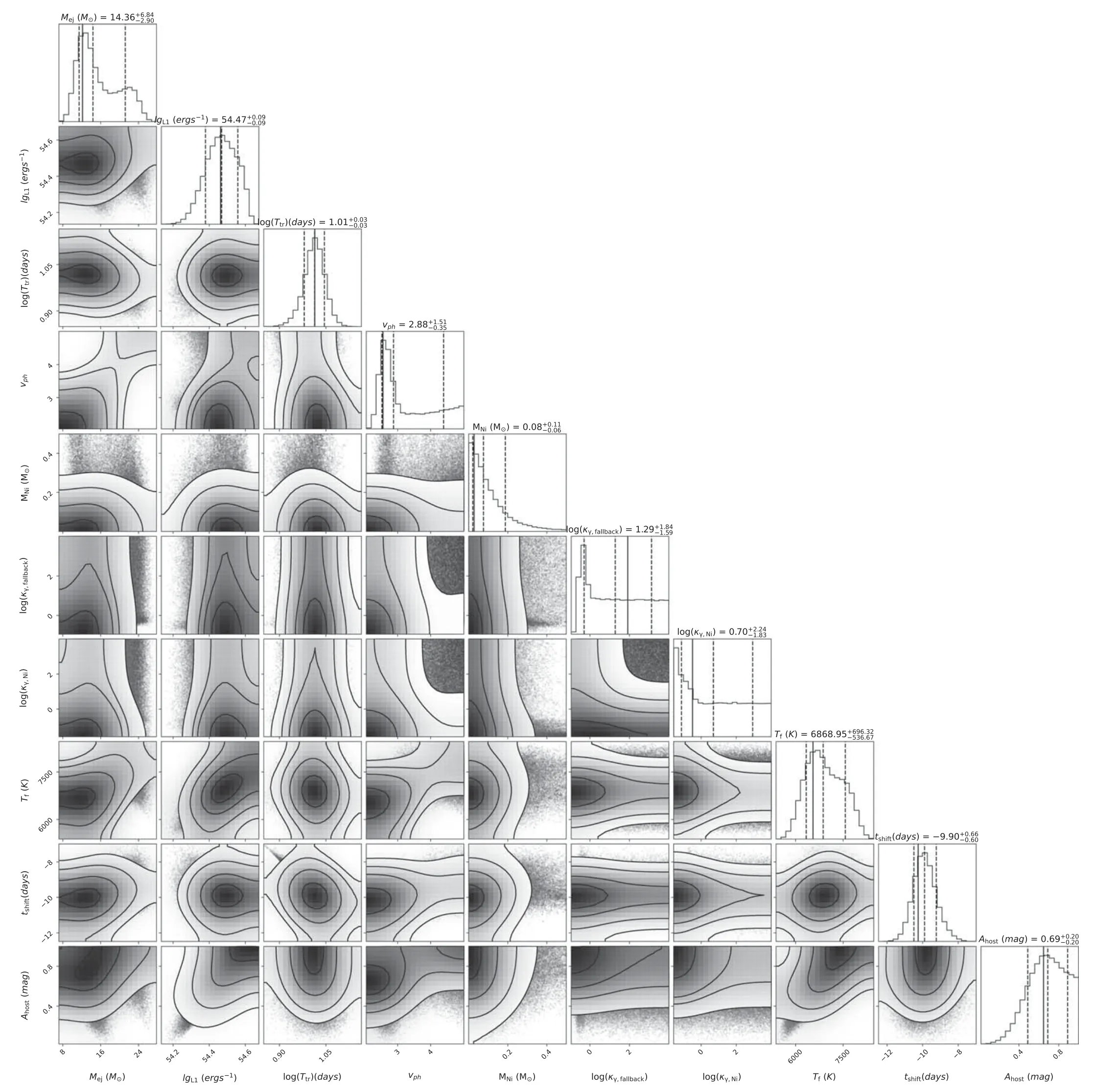
Figure A12.The corner plot of the fallback plus 56Ni model for the multi-band LCs of SN 2021bmf.The solid vertical lines represent the best-fitting parameters,while the dashed vertical lines represent the medians and the 1σ bounds of the parameters.

Figure A13.The corner plot of the fallback plus 56Ni model for the multi-band LCs of SN 2022ued.The solid vertical lines represent the best-fitting parameters,while the dashed vertical lines represent the medians and the 1σ bounds of the parameters.
猜你喜欢
杂志排行
Research in Astronomy and Astrophysics的其它文章
- Large-scale Dynamics of Line-driven Winds with the Re-radiation Effect
- A Study of Elemental Abundance Pattern of the r-II Star HD 222925
- Preliminary Study of Photometric Redshifts Based on the Wide Field Survey Telescope
- Solar Observation with the Fourier Transform Spectrometer.II.Preliminary Results of Solar Spectrum near the CO 4.66μm and MgI 12.32μm
- Density Functional Theory Calculations on the Interstellar Formation of Biomolecules
- Detection Capability Evaluation of Lunar Mineralogical Spectrometer:Results from Ground Experimental Data
